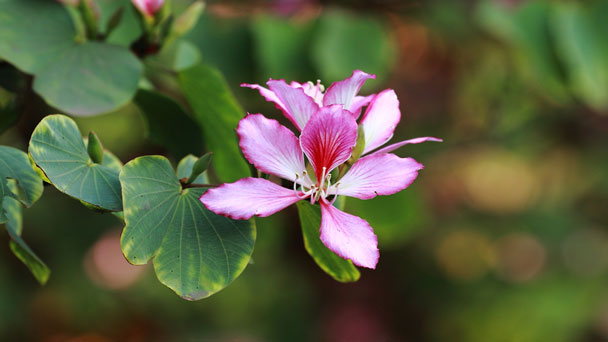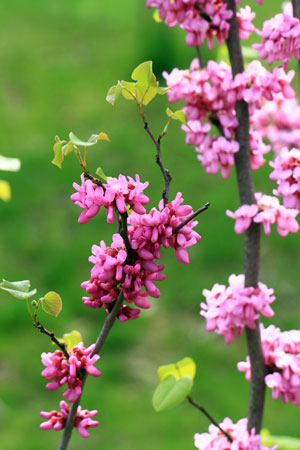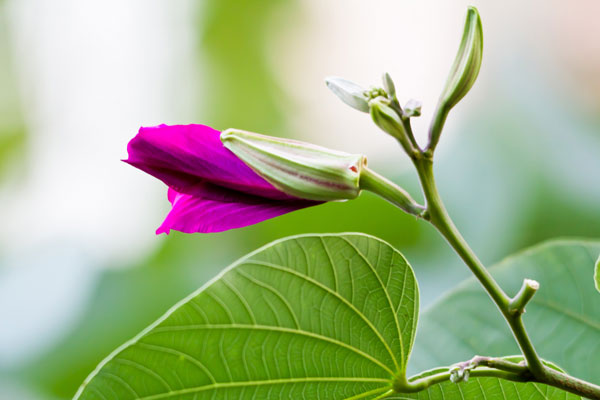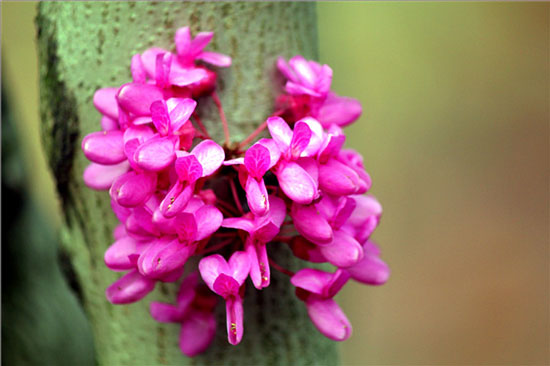Chinese Redbud (Cercis Chinensis) Grow & Care Guide
Written by Iris
Oct 13 2021

The flower shape of the Chinese Redbud is quite special. The top of the flower leaf is split, but the stalk is joined together, which means family harmony, reunion, completeness, and happiness, and symbolizes the relationship between family members. In addition to the meaning of family affection, Chinese Redbud can also imply love, and the simple love between men and women.
Seed will need to be prepared before planting by scarifying (scratching the seed coat to allow water to enter) followed by a cold treatment. Chinese Redbuds have adapted so that their seeds survive feeding by animals and cool winter weather. These treatments will mimic those natural processes.
Begin by using a nail file or sandpaper to gently scuff a small section of the seed coat. Wrap the seeds in a moist paper towel, then fold and place the paper towel in a sealed plastic bag. Store in the crisper drawer of your refrigerator for 60 days before planting.
Rather than going through the trouble of seed treatments, many gardeners simply allow established trees to self-seed in the landscape. Volunteer seedlings that appear the following season can be dug and planted in another spot. Some redbud varieties have been bred to produce limited seed pods, which will reduce the number of seeds produced and volunteer plants in the landscape. Keep in mind that seedlings from varieties bred for foliage, form or flower probably won’t have the same traits as their parents.
Remove some of the potting mix from the top of the container to find the root flare (the spot where the first roots emerge from the trunk). Nurseries tend to bury trees a little deep in the pot to prevent them from blowing over in the wind. You’ll want to plant your tree so that the root flare is even with the soil surface.
Lift the turf and dig a hole roughly 1.5 times the width and the same depth as the container. Avoid digging a hole that is too deep or wide. Trees planted in holes that are too deep tend to sink down, even if soil was backfilled initially to plant at the right depth. To encourage the roots to anchor in and spread out into the native soil, avoid digging a hole much wider than the container, and be sure to use your native soil without mixing in compost or other soil amendments. Water well and spread a healthy layer of mulch to limit weed competition and conserve water.
Like most young trees, newly planted Chinese Redbud will need at least one inch of water each week. Slowly pour water onto the soil below the dripline of the tree, allow the water to percolate into the soil, then pour a little more. Water every two or three days during the first growing season unless your garden receives at least an inch of rainfall. After the first season, you can cut back to watering as-needed in drought conditions.
Most experts agree that this shrub will do well as long as you keep it in partial to full sun, and it will be able to grow properly.
Specifically, we recommend that you place your cercis chinensis ‘Avondale’ in little to partial shade (only 2-6 hours of direct sunlight a day), to full and direct sun (more 6 hours of direct sunlight per day).
Water
In terms of watering, the Chinese Redbud is a fairly simple plant to take care of. This is mostly because it has a straightforward watering schedule and somewhat regular watering needs. Specifically, most experts agree that the Cercis Chinensis ‘Avondale’ prefers constant watering each week and more during the hot season. This is why it is considered a plant with relatively average needs in terms of water.
As a rule of thumb, you should remember to keep your Chinese Redbud in soil with moist but well-draining characteristics, as these will guarantee the right conditions for your plant to grow and thrive.
When you consider this, this is why you should aim to choose soil that has good drainage properties to keep the right moisture levels at all times.
In our experience, the famous ‘thumb’ or ‘finger’ test is what works best for the Chinese Redbud since with it, you will be able to give it the right amount of water, every time – regardless of the environment or placement where you do decide to keep it.
Larger branches will have a visible raised “collar” on the bark. Remove the Chinese Redbud branch just beyond the collar so that the collar remains on the tree. If you’re not sure exactly where the branch collar is, err on the side of leaving a small stub rather than cutting into the collar.
Small branches one-half inch or smaller in diameter can be removed with hand pruners. Shoots that are up to 3 inches in diameter should be removed with loppers. Any larger branches should be removed using a hand saw. If using a hand saw, begin with an undercut to prevent the weight of the removed limb from ripping bark and damaging the tree.
Prevention and Control: If possible, select resistant varieties. Keep nitrogen-heavy fertilizers to a minimum as well as over-irrigating as they encourage lush growth. Practice crop rotation and prune out or better yet remove infected plants.
Keep weeds down; use screening in windows to keep them out; remove infested plants away from non-infested plants; use a reflective mulch (aluminum foil) under plants (this repels whiteflies); trap with yellow sticky cards, apply labeled pesticides; encourage natural enemies such as parasitic wasps in the garden; and sometimes a good steady shower of water will wash them off the plant.
Keep weeds down, scout individual Chinese Redbud plants and remove caterpillars, apply labeled insecticides such as soaps and oils, take advantage of natural enemies such as parasitic wasps in the garden and use Bacillus thuringiensis (biological warfare) for some caterpillar species.
Once established they are hard to control. Isolate infested plants away from those that are not infested. Consult your local garden center professional or Cooperative Extension office in your county for a legal recommendation regarding their control. Encourage natural enemies such as parasitic wasps in the garden.
The Rising Sun offers spectacular color with new growth starting apricot, transitioning to vivid gold, and finally to bright green.
How to Grow Chinese RedbudChinese Redbud Propagation with SeedsChinese Redbud Propagation with Nursery PlantsHow to Care for Chinese RedbudChinese Redbud Lighting RequirementsChinese Redbud Soil CareChinese Redbud FertilizerChinese Redbud PruningChinese Redbud Pests & DiseasesChinese Redbud Varieties'Forest Pansy’'Ruby Falls''Texas White’
How to Grow Chinese Redbud
Chinese Redbud Propagation with Seeds
Chinese Redbud grows happily from seed. Young redbuds grow very quickly. When given plenty of water and good nutrition, a chinese redbud seedling can grow as much as 7 feet in five years. In addition to quickly filling space in the garden, young redbuds will also begin to bloom in as little as four years.Seed will need to be prepared before planting by scarifying (scratching the seed coat to allow water to enter) followed by a cold treatment. Chinese Redbuds have adapted so that their seeds survive feeding by animals and cool winter weather. These treatments will mimic those natural processes.
Begin by using a nail file or sandpaper to gently scuff a small section of the seed coat. Wrap the seeds in a moist paper towel, then fold and place the paper towel in a sealed plastic bag. Store in the crisper drawer of your refrigerator for 60 days before planting.
Rather than going through the trouble of seed treatments, many gardeners simply allow established trees to self-seed in the landscape. Volunteer seedlings that appear the following season can be dug and planted in another spot. Some redbud varieties have been bred to produce limited seed pods, which will reduce the number of seeds produced and volunteer plants in the landscape. Keep in mind that seedlings from varieties bred for foliage, form or flower probably won’t have the same traits as their parents.
Chinese Redbud Propagation with Nursery Plants
If you are planting a container-grown Chinese Redbud, use a spade, planting knife or hand saw to completely remove the circling roots from the outside of the root ball. Although this may seem drastic, new research suggests that once roots begin circling, they will always grow in that direction, even if they’ve been untangled.Remove some of the potting mix from the top of the container to find the root flare (the spot where the first roots emerge from the trunk). Nurseries tend to bury trees a little deep in the pot to prevent them from blowing over in the wind. You’ll want to plant your tree so that the root flare is even with the soil surface.
Lift the turf and dig a hole roughly 1.5 times the width and the same depth as the container. Avoid digging a hole that is too deep or wide. Trees planted in holes that are too deep tend to sink down, even if soil was backfilled initially to plant at the right depth. To encourage the roots to anchor in and spread out into the native soil, avoid digging a hole much wider than the container, and be sure to use your native soil without mixing in compost or other soil amendments. Water well and spread a healthy layer of mulch to limit weed competition and conserve water.
Like most young trees, newly planted Chinese Redbud will need at least one inch of water each week. Slowly pour water onto the soil below the dripline of the tree, allow the water to percolate into the soil, then pour a little more. Water every two or three days during the first growing season unless your garden receives at least an inch of rainfall. After the first season, you can cut back to watering as-needed in drought conditions.

How to Care for Chinese Redbud
Chinese Redbud Lighting Requirements
In terms of light & exposure, the Chinese Redbud requires partial to full sun in order for it to thrive under the right conditions.Most experts agree that this shrub will do well as long as you keep it in partial to full sun, and it will be able to grow properly.
Specifically, we recommend that you place your cercis chinensis ‘Avondale’ in little to partial shade (only 2-6 hours of direct sunlight a day), to full and direct sun (more 6 hours of direct sunlight per day).
Chinese Redbud Soil Care
Make sure to keep the Chinese Redbud in soil with moist but well-draining properties, so ideally, one that is made of clay, loam, chalk, and sand.Water
In terms of watering, the Chinese Redbud is a fairly simple plant to take care of. This is mostly because it has a straightforward watering schedule and somewhat regular watering needs. Specifically, most experts agree that the Cercis Chinensis ‘Avondale’ prefers constant watering each week and more during the hot season. This is why it is considered a plant with relatively average needs in terms of water.
As a rule of thumb, you should remember to keep your Chinese Redbud in soil with moist but well-draining characteristics, as these will guarantee the right conditions for your plant to grow and thrive.
When you consider this, this is why you should aim to choose soil that has good drainage properties to keep the right moisture levels at all times.
In our experience, the famous ‘thumb’ or ‘finger’ test is what works best for the Chinese Redbud since with it, you will be able to give it the right amount of water, every time – regardless of the environment or placement where you do decide to keep it.
Chinese Redbud Fertilizer
Fertilize your chinese redbud tree in early spring for best performance. Choose a balanced slow-release fertilizer.Chinese Redbud Pruning
Remove any dead, diseased, damaged or crossing branches to keep the tree growing strong. Try not to leave a stub. Stubs not only look bad, but they can also delay the tree’s ability to heal after pruning. It’s best to follow the limb all the way back to the next offshoot and cut just above the next branch.Larger branches will have a visible raised “collar” on the bark. Remove the Chinese Redbud branch just beyond the collar so that the collar remains on the tree. If you’re not sure exactly where the branch collar is, err on the side of leaving a small stub rather than cutting into the collar.
Small branches one-half inch or smaller in diameter can be removed with hand pruners. Shoots that are up to 3 inches in diameter should be removed with loppers. Any larger branches should be removed using a hand saw. If using a hand saw, begin with an undercut to prevent the weight of the removed limb from ripping bark and damaging the tree.
Chinese Redbud Pests & Diseases
Verticillium or Fusarium Wilt
Wilts may be contracted through infected seeds, plant debris, or soil. This fungus begins and multiplies during the cool, moist season, becoming obvious when weather turns warm and dry. Chinese Redbud Plants wilt because the fungus damages their water conducting mechanisms. Overfertilization can worsen this problem. Able to overwinter in soil for many years, it is also carried and harbored in common weeds.Prevention and Control: If possible, select resistant varieties. Keep nitrogen-heavy fertilizers to a minimum as well as over-irrigating as they encourage lush growth. Practice crop rotation and prune out or better yet remove infected plants.
Whiteflies
If a Chinese Redbud plant is infested with whiteflies, you will see a cloud of fleeing insects when the plant is disturbed. Whiteflies can weaken a plant, eventually leading to plant death. They can transmit many harmful plant viruses. They also produce a sweet substance called honeydew which can lead to an unattractive black surface fungal growth called sooty mold.Keep weeds down; use screening in windows to keep them out; remove infested plants away from non-infested plants; use a reflective mulch (aluminum foil) under plants (this repels whiteflies); trap with yellow sticky cards, apply labeled pesticides; encourage natural enemies such as parasitic wasps in the garden; and sometimes a good steady shower of water will wash them off the plant.
Caterpillars
Caterpillars can be highly destructive and are characterized as leaf feeders, stem borers, leaf rollers, cutworms and tent-formers.Keep weeds down, scout individual Chinese Redbud plants and remove caterpillars, apply labeled insecticides such as soaps and oils, take advantage of natural enemies such as parasitic wasps in the garden and use Bacillus thuringiensis (biological warfare) for some caterpillar species.
Scale Insects
Scales are insects, related to mealy bugs, that can be a problem on a wide variety of plants - indoor and outdoor.Once established they are hard to control. Isolate infested plants away from those that are not infested. Consult your local garden center professional or Cooperative Extension office in your county for a legal recommendation regarding their control. Encourage natural enemies such as parasitic wasps in the garden.

Chinese Redbud Varieties
Although most redbuds have lavender-pink flowers, certain varieties and cultivars have white, deep magenta, or light pink flowers. The leaf color may also vary, ranging from deep purple to chartreuse.'Forest Pansy’
is one of the most popular cultivars, with deep purple foliage and rose-colored flowers. The foliage retains its burgundy color throughout the summer in cooler climates, but lightens to green in the hot climates of the Southeast.'Ruby Falls'
is an excellent redbud for small spaces. Its weeping habit, red-purple flowers and heart-shaped leaves will bring elegance to any garden.'Texas White’
produces an abundance of bright white flowers and has leathery, glossy, bright green foliage. ‘Alba’ is another white-flowered variety, with light green foliage.The Rising Sun offers spectacular color with new growth starting apricot, transitioning to vivid gold, and finally to bright green.

Latest Updated
- Benefits of Bugleweed - 7 Science-backed Health Benefits
- Bugleweed Dangers & Side Effects - Is It Poisonous?
- How to Plant Evergreen Trees - What You Should Know
- When to Plant Evergreens - Grow Guide for Evergreen Trees
- 12 Wonderful Evergreen Shrubs for Your Garden
- 12 Popular Evergreen Plants with Pictures for Beginners
- When And How To Prune A Lilac Bush Like a Pro
- How to Grow & Care for Lilac Vine (Hardenbergia Violacea)
- Japanese Lilac Tree (Syringa Reticulata) Care & Propagation Guide
- Shumard Oak Pros and Cons - What to Know
Popular Articles
- Winter maintenance of Antirrhinum Majus
- How to Grow Terminalia Mantaly Tree
- How to Grow and Care for Crossostephium Chinense
- How to grow Antirrhinum Majus in spring
- Peristeria Elata (Dove Orchid) Profile: Info & Care Guide
- Underwatered Snake Plant (Sansevieria Trifasciata) - Signs And How To Fix
- How to Care for Brazilian Jasmine Plant (Mandevilla Sanderi)
- How to Grow & Care for Graptopetalum Purple Delight in Summer
- Rosa Chinensis (China Rose): Plant Growing & Care Tips
- How to Care for Baby Sun Rose (Aptenia Cordifolia)